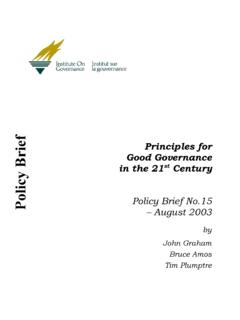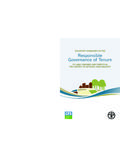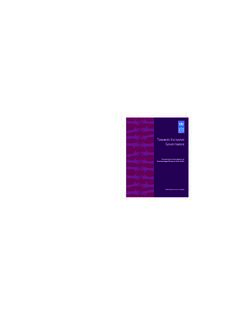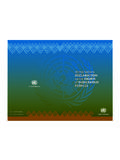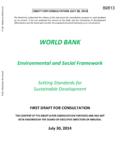Transcription of CONFERENCE ON INFORMATION TECHNOLOGIES …
1 CONFERENCE ON INFORMATION TECHNOLOGIES INFORMATION RESOURCES AND INTEGRATION: AN AGENDA FOR CHANGE UNIVERSITI BRUNEI DARUSSALAM LIBRARY 24-27 SEPTEMBER 2002 TITLE: NATIONAL INFORMATION TECHNOLOGY DEVELOPMENT AND E-BUSINESS INITIATIVES IN BRUNEI DARUSSALAM by: Yap Lye Tin BIT Secretariat INFORMATION Technology and State Stores Department Ministry of Finance Brunei Darussalam e-mail: Date: 25 September 2002 Universiti Brunei DarussalamABSTRACT The development of INFORMATION and Communication Technology (ICT) in Brunei Darussalam is guided by and coordinated in accordance to the National IT Strategic Plan named the IT2000 and Beyond. The implementation of the plan officially started with the formation of the Brunei Darussalam INFORMATION Technology (BIT) Council in October 2000. The plan is further supported by the fund of about BND1 billion pledged in the 8th National Development Plan 2001-2005 for the implementation of IT related programmes and projects.
2 This paper presents a brief overview of the current INFORMATION and Communication Technology (ICT) development in Brunei Darussalam in the new millennium following the establishment of the IT2000 and Beyond and the formation of the Brunei Darussalam IT Council. It provides a brief background of the country, the National ICT strategic framework prescribed in the National IT Strategic Plan, and the IT development landscape prior to the establishment of the National IT Strategic Plan. The paper then proceeds to elaborate on the current implementation of some of the action plans prescribed in the National IT Strategic Plan and the challenges encountered, with focus on the e-Business strategic drives. It also gives some insights into the public and the private sector ICT initiatives on driving the e-business development in the country and highlights the importance of integration, coordination and collaboration amongst the sectors.
3 INTRODUCTION This paper focuses on the development of INFORMATION Communication Technology (ICT) related activities currently being actively undertaken in Negara Brunei Darussalam to promote the wider acceptance of ICT in sustaining and enhancing the business competitiveness both in the Public and the Private Sectors. The paper provides some background INFORMATION and development on several key initiatives, including the following: Telecommunications Infrastructure in Brunei Darussalam The National IT Strategic Plan IT 2000 and Beyond The 8th National Development Plan (2001 2005) Public Sector ICT Initiatives (e-Government) Private Sector ICT Initiatives (e-Business) BRUNEI DARUSSALAM INFORMATION TECHNOLOGY DEVELOPMENT In Brunei Darussalam, INFORMATION Technology (IT) has always played a significant and important role in the positive contribution to the country s socio-economic development.
4 The use of IT in the Public Sector started in the early seventies with the financial and telecommunications institutions being the early pioneers in applying IT for data processing to support their business functions and operations. Since then the use of IT within the Public Sector has evolved and developed quite noticeably through the long learning process. The growing awareness of IT capabilities as a potential strategic business tool has resulted in the extensive application of IT in the Public Sector in their business processes. In addition to just being a supporting mechanism for data processing, IT is increasingly being use as a strategic tool in many agencies in enhancing their business process efficiency and competitive advantage. The introduction of the local Internet Service Provider (ISP) in the mid-nineties coupled with accessibility to more advance IT appliances and capabilities has further accelerated the wider acceptance of IT within the Public Sector taking advantage of the Internet business opportunities.
5 Today, the diffusion of IT applications in the Public agencies have grown to a level where the pervasive use of desktop Personnel Computers (PCs) are commonly seen at the counters of most agencies. In the Private Sector, the large business entities in the oil industry, airlines and banking sectors were the early pioneers in the use of IT to support their respective business processes and operations. Being the drivers in the country s economic activities, these organizations have always been in the forefront in embracing IT to perform their businesses. However, with the rising emergence of small and medium enterprises (SMEs) in the late eighties and early nineties driven by the conducive economic environment, the diffusion of IT in the Private Sector has to some extent increases both in the large corporations and SMEs.
6 The trend in the applications of IT in the Private Sector continued to grow at a steady rate as TECHNOLOGIES become more affordable and easy to use. The accessibility to the Internet and the World Wide Web as enabler to reach out to a wider audience has further encouraged business sectors to continue invest in IT to sustain and enhance their business advantage. The accessibility of the Internet and the fallen costs of TECHNOLOGIES have also increased the personal and home users of IT in Brunei Darussalam. Communication Infrastructure Brunei Darussalam has a small population of about 332,844 people (2001 population census, Brunei Economic Bulletin, July 2002) with a land area of 5,765 square kilometer. It has one of the best basic telecommunication infrastructures in this region with a tele-density of about 25% (25 telephone lines per 100 people).
7 The Brunei Global Multimedia Info-communication Network or RaGAM 21 commissioned in 1999 will eventually link up every major town, village, school, institution and commercial area in the country. Currently, almost every strategic area in Brunei-Muara District is linked to RaGAM21 network which in turn is linked globally via satellite (Indian Ocean Region and Pacific Ocean Region) and submarine cable systems (SEA-ME-WE3, Brunei-Singapore and Brunei-Malaysia-Philippines) At present, there are five Internet Service Provider (ISP) licences being issued, out of which only two are in operations. The first operator being the Telecommunications Department (JTB) ( ), which began its service in September 1995 ( ). The second ISP, ( ) operated by DataStream Technology (B) Sdn Bhd (DST) started its operations in October 2000.
8 The country is expected to see more competitive pricing and services with the liberalisation of Telecommunication Services through the corporatisation of Telecommunications Department (JTB) with effect from 1 April 2003. Legal Framework Legal infrastructure for promoting and supporting e-Commerce in Brunei Darussalam has been given priority in its implementation. These include the following: Copyright Order 2000 to address Intellectual Property Rights (IPR) issues and to encourage innovation, creativity and technology investment in consistence with World Trade Organisation (WTO, TRIPS) Computer Misuse Order 2000 to address the issue of security and to protect legitimate users against potential misuse of computers Electronic Transactions Order 2000 to address issues on Electronic Transactions and the provision for the establishment of regulatory regime for Public Key Infrastructure (PKI) Class License Notification and the Internet Code of Practice under the Broadcasting Act 2001.
9 Overall, the legal framework is undergoing enhancement to create a favorable environment for electronic use and allow provision for cyber laws based on international standards such as the United Nations CONFERENCE on International Trade Law (UNCITRAL) Model Law (Attorney General s Chamber) ( ). In this respect, Brunei Darussalam has been considered as one of the fore-runners within ASEAN to establish the e-commerce legislation. Regional Cooperation and Initiatives As a member of Association of South-East Asian Nations (ASEAN), Asia-Pacific Economic Cooperation (APEC), and Non-Aligned Movement (NAM), Brunei Darussalam is committed to the implementation and progress of the e-ASEAN ( ) and e-APEC ( ) initiatives highlighted under the respective frameworks and the NAM Center for South-South Corporation (NAM CSSTC) ( ) work programmes.
10 Hence, Brunei Darussalam is actively participating in the e-commerce and e-government work programs under the APEC fora and e-ASEAN initiatives to share and learn from the experiences and best practices of other member countries towards the ICT development in Brunei Darussalam and narrowing the digital divide among member countries. THE NATIONAL IT STRATEGIC PLAN IT 2000 AND BEYOND To provide full commitment and support in ICT development, His Majesty the Sultan dan Yang DiPertuan Negara Brunei Darussalam consented to the establishment of the National INFORMATION Technology Council (BIT Council) in October 2000 with the aim to lead and facilitate the strategic development and diffusion of the state-of-the-art IT for the entire nation ( ). The goal is to enable the maximum exploitation of IT for national prosperity by pursuing three core strategies outlined in the National IT Strategic Plan (IT2000 and Beyond).

